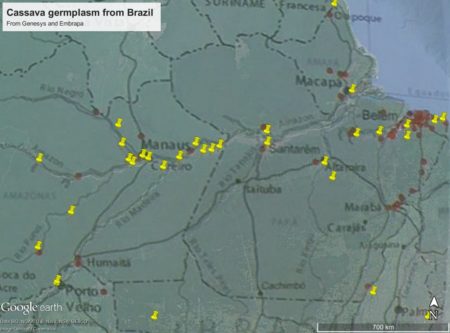Nice monologue from Dr Sipke Joost Hiemstra, Director of the Centre for Genetic Resources, the Netherlands (CGN) at Wageningen University & Research and Head of the Animal Genetic Resources Group, on plant and animal genetic resources collections in Europe. But mainly animal genebanks, and what the Horizon2020 IMAGE project is doing about them.
Nibbles: Garlic history, Collecting, GMO course, Rice genebank, Mango diversity, Chilli diversity, Virtual plant breeding, Navel orange, LA tree, Cotton sustainability, Saudi agritourism
- Trying to promote a “poor person’s crop”? Try the garlic trick, ennobling.
- A Reference Manual for Expedition Plant Collectors, courtesy of the The Arnold Arboretum.
- Cornell runs a MOOC on GMOs. How about one on genebanks, eh?
- Maharashtra could maybe use it.
- You can never have too many mangoes.
- Or dried chillies.
- Next generation plant breeding.
- Riverside protects its famous citrus tree.
- But not all famous California trees are so lucky.
- Making cotton sustainable. Hard row to hoe.
- Saudi farm tourism. Even harder.
More on cassava germplasm from Brazil
You might remember a post from a couple of weeks back comparing the localities of cassava accessions in Genesys (mostly conserved at CIAT) with cultivation of the crop in Brazil. I ended that little piece with the observation that when data from the national genebank system of that country finally makes its way into Genesys, which should not be long now, it will be possible to really figure out where the gaps are in the “global” collection of the crop. Well, as it happens, there was a Tweet just recently which included a photo of a map of where Embrapa’s cassava accessions come from:
Embrapa has collected germplasm from throughout the Amazon region and has characterised this using 20,000 SNPs. Main disease problem is soft rot during heavy rains in this rainforest zone. Working on identifying pathogens & finding genes linked to resistance @IITA_CGIAR @embrapa pic.twitter.com/7go8eipUhn
— James Legg (@jamesplegg) April 28, 2018
So, quick as a flash, I imported it into Google Earth as an image overlay, and after much fiddling to make it fit on top of the background provided by GE (only partially successfully), was able to compare it with the accessions in Genesys:
The two sets of accessions (red for Embrapa, yellow for CIAT) look nicely complementary at a glance. Maybe the gaps in one collection are adequately covered by the other, and vice versa (which of course then brings up the issue of safety duplication, but that’s another post). Or maybe not: this is a really crude way of looking at the data. But it does point to the importance of data sharing and the need for collaboration among genebanks, national and international.
Brainfood: Definitions, Atlantic goats, Sorghum photoperiod, Maize erosion, Dactylis diversity, Chickpea diversity, Social media, TR4, Diet change
- ‘Genetic resources’, an analysis of a multifaceted concept. You don’t say.
- Exploring the genetic diversity and relationships between Spanish and Moroccan goats using microsatellite markers. Different, but connected, except for the ones in the Canary Islands.
- Latitudinal Adaptation of Flowering Response to Photoperiod and Temperature in the World Collection of Sorghum Landraces. Out of 20,710: 1697 photoperiod and temperature insensitive, 18,766 photoperiod sensitive and temperature insensitive and 247 photoperiod and temperature sensitive.
- Conserving maize in gene banks: Changes in genetic diversity revealed by morphological and SSR markers. Not good ones.
- AFLP-based genetic diversity of wild orchardgrass germplasm collections from Central Asia and Western China, and the relation to environmental factors. Strongish ecogeographic structure. Good to see old school markers still in use.
- Genetic Diversity, Population Structure, and Genetic Correlation with Climatic Variation in Chickpea (Cicer arietinum) Landraces from Pakistan. Some differentiation along elevation and temperature gradients despite limited overall diversity.
- Capturing genetic variation in crop wild relatives: An evolutionary approach. Environmental data is your friend. But we knew that, right?
- New Geographical Insights of the Latest Expansion of Fusarium oxysporum f.sp. cubense Tropical Race 4 Into the Greater Mekong Subregion. Be afraid.
- The opportunity cost of animal based diets exceeds all food losses. Never happen.
- An Introduction to Social Media for Scientists. It might happen, if you tweet it.
- Tweet success? Scientific communication correlates with increased citations in Ecology and Conservation. See what I mean?
Brainfood: Seed libraries, Nepali veggie seeds, Agricultural ES, Zn rice, Sub rice core, SoD, D2N, Root crops knowledge, Horse diversity
- Civic seeds: new institutions for seed systems and communities—a 2016 survey of California seed libraries. 6456 seed packets borrowed annually, by 4776 people, from >100 seed libraries, with a 6% return rate.
- Vegetables production and marketing: practice and perception of vegetable seed producers and fresh growers in Nepal. Producers like hybrids, consumers prefer open pollinated varieties. Oh, and drying is a problem. No word on whether seed libraries might help.
- Exploiting ecosystem services in agriculture for increased food security. Services don’t include crop diversity, apparently.
- Molecular Diversity Analysis for Zinc Deficiency Tolerance under Aerobic Rice (Oryza sativa L.) Ecosystem. Two major groups.
- Developing Mini Core of Rice Germplasm for Submergence Tolerance. Really mini. Maybe too mini?
- CIMMYT’s Seeds of Discovery Initiative: Harnessing Biodiversity for Food Security and Sustainable Development. A “visionary investment.”
- Temporal change of Distance to Nature index for anthropogenic influence monitoring in a protected area and its buffer zone. I want a Distance to Genebank index.
- Indigenous knowledge and household food security: the role of root and tuber crops among indigenous peoples in the Northern Philippines. The youth are losing it.
- Decline of genetic diversity in ancient domestic stallions in Europe. It was artificial selection during the Iron Age.
